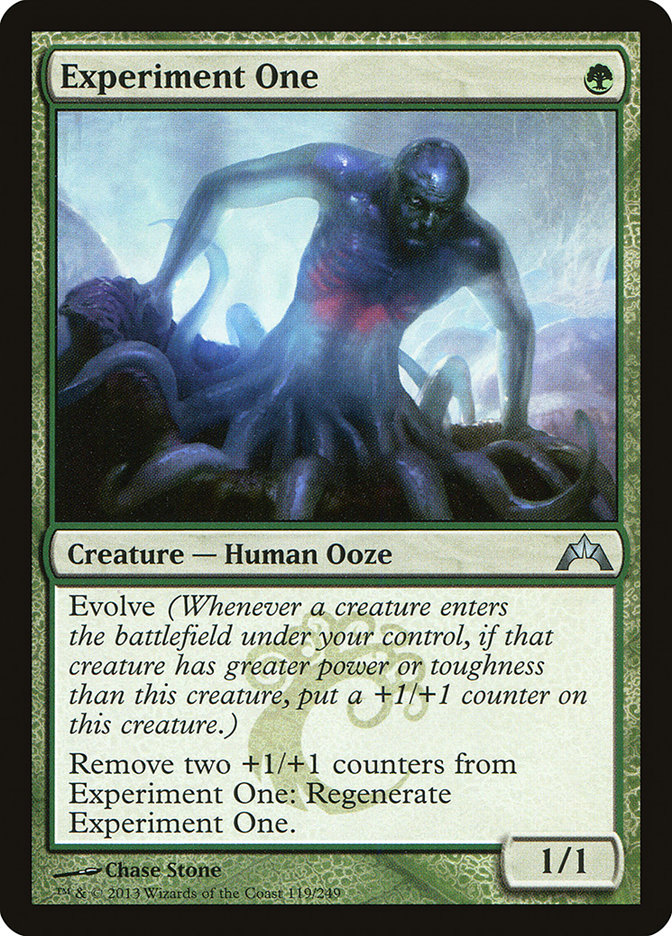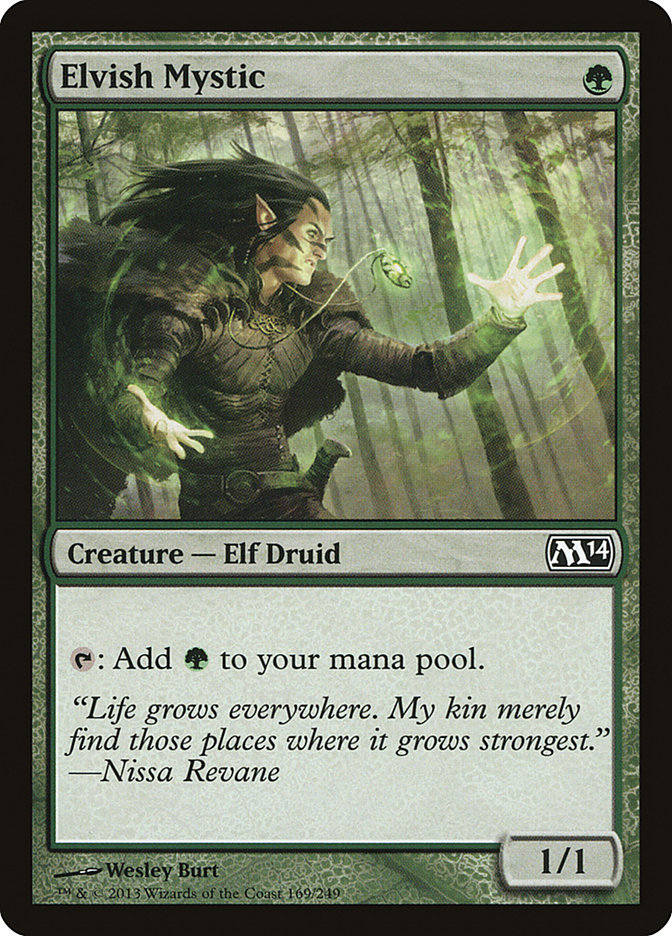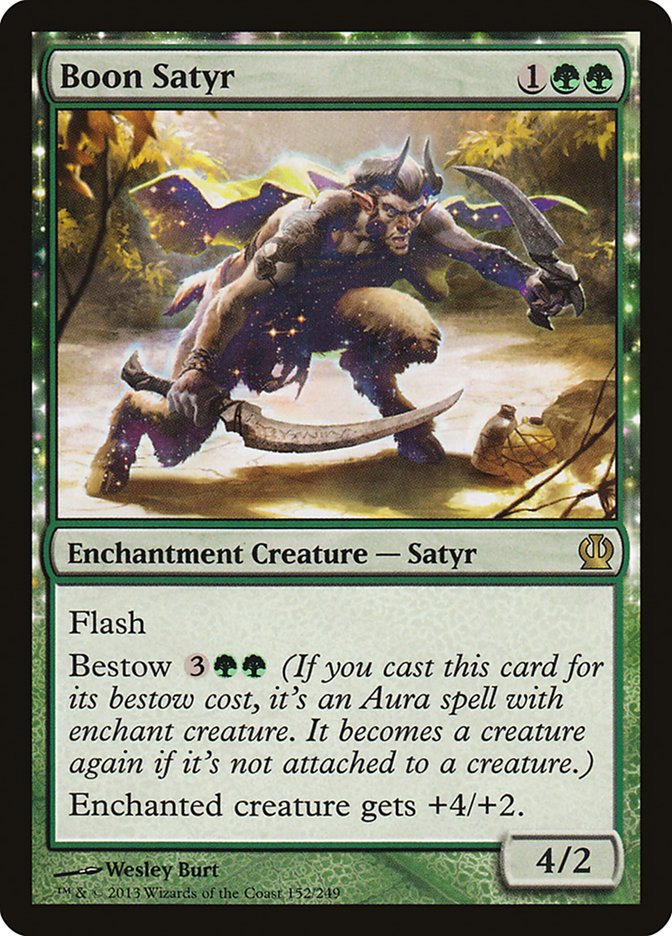The very first deck I built for Pro Tour Theros was G/B Aggro. I felt like the devotion mechanic meant that games in the format would very much be about keeping things off your opponent’s side of the board, and I wanted to be able to play a significant amount of removal that was flexible enough that it wasn’t dead against control decks. The decks I expected to be big players at that point were Esper Control, Mono-Red Aggro, and various types of Devotion decks—incidentally, a world that turns out to be very similar to the one in which we now live.
My initial builds of G/B Aggro were heavily focused on the "aggro" part. Experiment One was one of the best cards in similar decks in the Block format because of its resilience against Supreme Verdict as well as its ability to grow big enough to be a factor against other creature decks, which is a great deal for one mana. I was torn though because I also wanted to play with Elvish Mystic to accelerate my draws with Dreg Mangler; Varolz, the Scar-Striped; and other more expensive creatures.
 |
vs. |
 |
You can’t really afford to play four copies each of both Experiment One and Elvish Mystic however. Each is a card that is powerful in the early turns of the game and drops off significantly in value as the game progresses. Playing a full complement of each means that your deck has a lot of weak draws in the mid to late game, and unlike other aggressive creatures, like the one-drops in an aggressive red deck, you’re also unhappy to draw a hand full of them to start the game. While a hand of two Rakdos Cacklers and two Firedrinker Satyrs threatens to kill your opponent extremely quickly, the same hand with Experiment Ones and Elvish Mystics threatens to do a whole lot of nothing.
My work on G/B was interrupted by a desire to build Green Devotion. It was that deck that first taught me that Experiment One doesn’t have a home in multicolor decks in the current format. My first build of Green Devotion was also quite aggressive, featuring the same mix of Elvish Mystics and Experiment Ones, but this time supplemented with Burning-Tree Emissary; Kalonian Tusker; Reverent Hunter; and Polukranos, World Eater among others.
Experiment One was occasionally powerful, but it continued to suffer from the same issues as in my G/B deck—it was a weak draw late and matched up poorly with Elvish Mystic. Additionally, with even more games under my belt, I found that Experiment One really didn’t perform well alongside lands that enter the battlefield tapped. The strength of Experiment One comes from curving out smoothly, and the tempo loss from any hand with a Temple or Guildgate is magnified if you also have to spend a turn casting Experiment One or risk it staying a 1/1 for the entire duration of the game.
That realization ultimately led me to give up on the various aggressive decks I was working on for the Pro Tour. Most of my effort immediately before the event was put into an aggressive Junk deck that struggled not only with the issue of lands that entered the battlefield tapped but with colored mana in general. Experiment One was even more troublesome in that deck because you had to play Temple of Silence, which you couldn’t even use to cast it off curve. At that point, I was out of time, and I defaulted to playing the R/G Devotion deck the rest of the team used.
After the Pro Tour though when I’d had some time to reflect, I started looking back on where I felt I went wrong in my testing process. Patrick Chapin had been quite successful with his B/W Midrange deck, and he asked me how I of all people hadn’t shown up with some kind of midrange Thoughtseize / Doom Blade deck given my preferences. My problem as it turned out was trying too hard to play with Experiment One. I went back to where I’d left off, and after some tinkering I came up with this:
Creatures (27)
- 3 Scavenging Ooze
- 4 Dreg Mangler
- 4 Lotleth Troll
- 2 Varolz, the Scar-Striped
- 4 Elvish Mystic
- 2 Polukranos, World Eater
- 4 Boon Satyr
- 4 Reaper of the Wilds
Lands (24)
Spells (9)
Sideboard

After the return of Esper Control and the rise of Mono-Black Devotion in the wake of the Pro Tour, I thought that an aggressive deck with Thoughtseize once again seemed like a great place to be. With so many Thoughtseizes and Underworld Connections in opposing decks, I wanted to be able to pressure people and punish them for paying so much life. My mind turned back to G/B, especially because it has access to so many resilient creatures in this removal-filled world we’re living in. Not only can Lotleth Troll regenerate from Supreme Verdict or Hero’s Downfall, but it can’t even be targeted by Doom Blade or Ultimate Price. In fact, the hardest kind of creature to kill in the current format is a multicolored black creature.
That last tidbit is part of the reason Reaper of the Wilds is so good right now. Reaper is a card that I tried a bit in my Pro Tour testing but never found quite the right shell for. As a 4/5 for four mana, it’s not the sort of card whose power level jumps out at you. After all, Deadbridge Goliath barely saw any play, and Polukranos is legal—why would you play Reaper? The answer lies in the texture of the current format.
Because devotion is so important to break up, decks are jammed full of removal spells—remember my article from last week? Polukranos can be killed by Doom Blade, Ultimate Price, Selesnya Charm, and Azorius Charm—none of which can realistically deal with Reaper. And even the ubiquitous Hero’s Downfall or Detention Sphere can’t take it off the board if you’re able to keep mana up to activate its hexproof ability. In a world full of removal, there’s a lot to be said for the ability to survive.
I’ve also seen a lot of people totally ignore the scry ability on Reaper when evaluating the card, but once I started playing with it more, I realized that it can offer an incredible amount of value over the course of a game. How many times have you played a long drawn-out game in which one player was able to squeak out a win simply because they drew two or three more spells while their opponent drew lands?
People seem to have the misconception that scry is an effect that you want early in a game to set up your draws, but it’s much more powerful late when the value of a land has diminished to effectively zero. When you have a Reaper in play—or even better multiple Reapers—you can force trades in stalemate situations to generate scry triggers, which will give you the ability to dig to more action than your opponents. Preordain was so good it was banned in Modern, and people overlook that it was also one of the best cards in Caw-Blade when it was legal in Standard. Scrying is a powerful effect, and Reaper lets you do it a lot.
Reaper is also far better than it looks in combat. While it’s only a 4/5, it can also gain deathtouch, which means it can trade up against anything your opponent might have. Desecration Demon? Arbor Colossus? Advent of the Wurm token? Even double or triple blocking it can never end well for your opponent, which is more than can be said of many larger creatures. Its ability to naturally gain hexproof also makes it a great target for any kind of enhancement, like scavenge from Varolz or bestow from Boon Satyr.
Boon Satyr was a big card that I didn’t appreciate enough in my testing for the Pro Tour. I had decks using the card but never realized how good it was because the rest of the shells of those decks weren’t strong enough. Satyr offers something very similar to Varolz and Scavenging Ooze in that it provides a deck with a tremendous amount of more late-game power without requiring you to dramatically increase your mana curve. Satyr is even better at it because it represents a very real threat by itself against control as an instant four-power creature for three mana and also because of the surprise factor that comes with flash. You can frequently totally ruin someone’s combat math with an instant-speed bestowed Satyr.
It’s also worth noting that Boon Satyr makes Blood Baron of Vizkopa far less of an issue than it might otherwise be. The ability to ambush an opposing Blood Baron and kill it is huge –or even better to ambush it with bestow on an Elvish Mystic and have the Boon Satyr itself live to tell the tale. Really, Boon Satyr does just about everything, and it is a card that was conspicuously missing from my pre-Dublin builds of the deck.
The removal package is something I feel like I got right from the start though. Everyone has been singing the praises of Hero’s Downfall since the Pro Tour, but Abrupt Decay is simply awesome right now too. It’s great at killing devotion-enabling creatures, from Frostburn Weird to Nightveil Specter to Boros Reckoner, and also happens to be excellent against the Detention Spheres and Underworld Connections out of the control decks.
One of the biggest problems a midrange style of deck can face is drawing the wrong mix of cards against the wrong opponent. The surest way to lose against control is to draw a fist full of Doom Blades, while Duress is not what you want to see in your hand against aggro. The beauty of this deck’s reactive cards is that they are all universal. Sure, I’d rather not draw a bunch of Thoughtseizes against a beatdown deck or multiple removal spells against Esper Control, but I can find a use for them, which is a huge deal.
That modality of its reactive cards makes this deck sideboard extremely well too. Against opposing creature decks, you’re able to bring in a bunch of additional efficient removal and become effectively a Doom Blade deck while shaving some of your less effective creatures, while against control you can upgrade your removal to disruption and hard-to-answer threats.
Quite a few of the cards this deck gets to sideboard have a ton of flexibility as well. Mistcutter Hydra is a foil to Mono-Blue Devotion as well as a difficult-to-answer threat against control that can’t be easily trumped by Blood Baron. Golgari Charm was originally included as an answer to Supreme Verdict that could also kill Detention Sphere, but it’s also incredible against the Anger of the Gods and Chained to the Rocks of Naya Control, to say nothing of how good it is as a one-sided sweeper against aggressive decks like the W/R deck [author name="Ben Lundquist"]Ben Lundquist[/author] used to win the SCG Standard Open in Los Angeles. Even Gift of Orzhova has multiple uses, as a life-gain plan against aggressive red decks and a tool to help break ground stalemates against other green opponents.
I’ve been playing this deck for the past several weeks on Magic Online, and it has been performing incredibly well. I’ve managed to support my girlfriend Natalie’s very expensive drafting habit through winning in two-player Standard queues almost exclusively, which requires a very high win rate to break even let alone to turn a profit. If you’re looking for a new deck to take for a spin, I highly recommend it.
Until next time,
bmk


